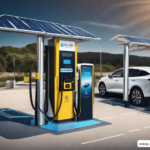Table of Contents
Hey, fellow eco-conscious folks and tech enthusiasts! Have you caught wind of the electric vehicle (EV) excitement on the streets lately? A super cool revolution happening in the world of cars, and it’s all about these amazing rides that are kind to the environment. Governments worldwide are teaming up to steer us towards greener transportation. It’s like they’re getting together on a mission to make our future rides way less harmful to the environment.
Now let’s talk about Steps taken by the government to increase the growth of electric vehicles
In the present human era, authorities around the globe are proceeding in numerous ways to encourage the rapid growth of electric vehicles (EVs) in their nations.
Explore the top companies of electric vehiclesSome of the key steps taken by lawmakers include.
- Financial incentives and Taxes: Governments are rewarding the numerous rewards to escalate the purchase and utilization of EVs. These rewards are tax credits and exemptions from road taxes and tolls etc. For example, in the United States, the federal government offers a tax credit of up to,500 for the purchase of EVs.
- Infrastructure development: Authorities are giving adequate amounts of funds to increase the comfort and ease access of to charging for battery electric vehicle owners. This includes the setup of charging stations in general public places which will give the best way to charge the EVs for example parking areas, shopping complexes, and main roads
- Regulations and policies: Governments are implementing regulations and policies to encourage the adoption of EVs. Arrangements for the number of electric cars (EVs) on the road, noticing vehicle discharge rules, as well as encouraging the use of renewable energies for the generation of electricity are all part of this.
- Public education and awareness: Authorities are implementing programs and public awareness for the general public to remove misunderstandings of people about EVs as well as increase knowledge about the benefits of electric vehicles. Information on EV technology, EV recharging procedures, and the benefits of EVs for the environment are all included in this.
- Partnership with the private sector: Governments are partnering with private companies and organizations to promote the development and adoption of EVs. Partnership with automobile companies to make the best EV latest models, and partnering with ride-sharing companies to promote the use of EVs.

1. Financial incentives and Taxes on Electric Vehicles:
Spur is a set of steps taken by the authorities of respective nations or other organizations to encourage certain actions. In the condition of electric vehicles (EVs), financial incentives are created to encourage buyers to purchase and utilize electric vehicles by reducing their overall cost.
Financial incentives for EVs may comprise credits of taxes, repayments, accords, and other types of financial assistance. For example, some governments offer tax credits or repayments to owners of electric vehicles, which eventually can decrease the total cost price of an EV. Other incentives may include exemptions from road taxes, tolls, or parking fees. Financial incentives are frequently utilized in mergers in other ways for example the evolution of EV recharging infrastructure or rules to encourage the taking on EVs with these kinds of rewards goal to make EVs more accessible and cheaper for the consumer benefits
2. Infrastructure development:
Infrastructure development means the procedure of making, upgrading, and enlarging the physical systems and facilities important for social activities to take place whenever needed. In the condition of electric vehicles (EVs), infrastructure development refers to the development and enlargement of the recharging infrastructure dominant to encourage the widening of the EV market.
EV charging architecture incorporates a network, recharging station, and those which are related equipment that provides power to charge the EV accumulator. architecture development involves constructing new charging power stations, developing old ones, and plugging charging stations into a network that can notice and manage the recharging overall from the initial to the end process.
Infrastructure development is dominant for the global adoption of EVs because it makes sure that EV owners have convenient and accessible places to recharge their vehicles. As more EVs are opted for, the need for charging stations will continue to escalate. Therefore, architecture enhancement is much needed to boost the growth of the EV market and to decrease carbon emissions from transportation.
Authorities and other organizations are investing good amounts of funds in infrastructure development to encourage the best growth of the EV market. They are building charging stations in general public places such as parking areas, shopping complexes, and main roads to escalate the convenience and accessibility of charging for electric vehicle owners.
3. Regulations and policies:
Regulations and policies mean the certain rules created by authorities and other private organizations to attain desired goals and objectives. In the condition of electric vehicles (EVs), regulations and policies are created to encourage the universal option of electric vehicles as well as to decrease the carbon emissions connected with transportation.
Regulations and policies that are associated with EVs can take numerous forms, including emissions rules for vehicles, requirements for fuel efficiency, and good rewards for the general public and companies. For example, governments may plan for the number of EVs on the road or impose emissions standards that require automakers to produce more lower-emission vehicles. Some lawmakers also offer financial incentives in their respective countries for example tax credits or repayments, to encourage consumers to purchase electric vehicles.
In addition, to these measures, authorities may also encourage the utilization of reusable energy resources for power generation, which can eventually further decrease the carbon emissions which is associated with EVs. This involves the implementation of policies that promote the growth of wind and solar power, along with regulations mandating utilities to produce a specific proportion of their electricity from renewable sources.
In conclusion, regulations and policies that are associated with EVs are dominant factors for encouraging the universal option of EVs and benefiting the environment creating a supportive regulatory and policy environment, governments and other organizations can help to accelerate the growth of the EV market and transition to a more sustainable transportation system.
4. Public education and awareness:
The term public education and awareness means initiative taken by authorities and other organizations to give data and escalate understanding among the general public about a particular matter, topic, or technological advancement. In the condition of electric vehicles (EVs), public education and awareness efforts aim to raise understanding and acceptance of electric vehicle technology, as well as to notice any important subjects or misconceptions that people may have about EVs. public education and awareness involve initiatives undertaken by authorities, encompassing informative awareness campaigns, public gatherings, educational materials, and broadcast coverage these important efforts may give information about how EVs function, their respective advantages, the procedure to charge an EV, and the eco friendly.
Public education and awareness about EVs are important because they can help to increase the adoption of EVs and to reduce carbon emissions from transportation providing accurate information and addressing concerns and misconceptions, governments and other organizations can help to build trust and acceptance of EVs among the general public.
Moreover, public education and awareness efforts can also encourage people to adopt more sustainable transportation habits, such as walking, biking, or using public transportation this can further reduce carbon emissions from transportation and help to build more sustainable communities.
5. Partnership with the private sector:
The term partnership with the private sector means cooperation between authorities and privately owned companies to complete desired common goals and objectives. When it comes to electric vehicles (EVs), partnerships with the private sector are important for promoting electric vehicles opted by the general public and for developing the architecture as well as technology which is important to support the growth of the electric automobile market.
Partnerships with the private sector is also a flexible term for example joint ventures, public-private partnerships, or collaborations between governments and private companies on research and development. Privately owned companies can bring expertise, innovation, and resources to help authorities to achieve their electric vehicle-related goals.
For example, private companies can invest an adequate amount of money in the development of EV charging infrastructure and charging stations as well which is essential for the growth of the electric vehicle market. They can also invest in research and development of new EV technologies for example batteries and motors, that can enhance the performance and durability of electric vehicles which is most necessary.
Moreover, partnerships with the private sector can help to create new business opportunities and jobs in the EV industry. This can promote the growth of the economy and development.












One thought on “Boosting Growth of Electric Vehicle Initiatives by Government: Key Steps Revealed 2024”